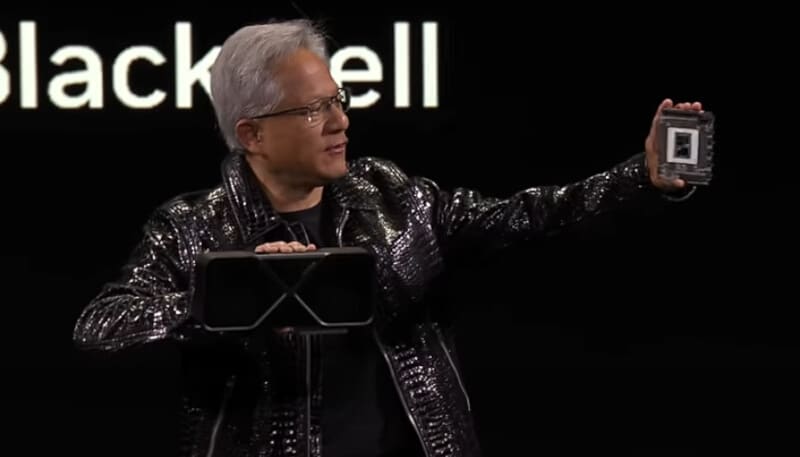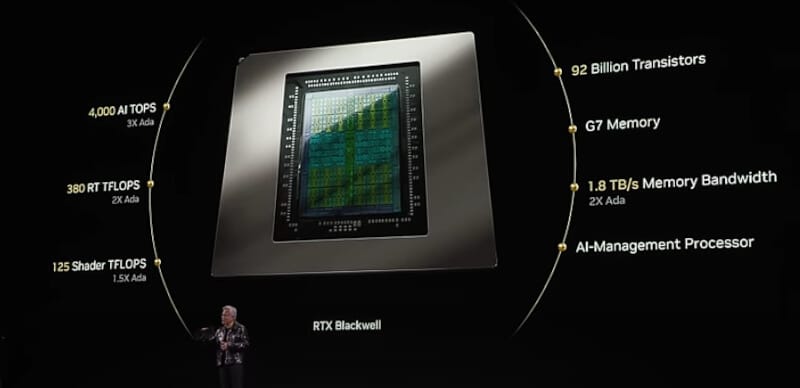On Jan. 6th, NVIDIA prepared a presentation for the new GeForce RTX 50 at South Korea’s CES 2025 convention. Tech enthusiasts and journalists later publicly announced on Jan. 7th, praising its CPU’s processing power and new functionalities. However, NVIDIA’s GE RTX 50 series is being judged for what it offers for an expensive price. Game developers and gamers are debating whether to invest in it for future PC titles.
What NVIDIA GeForce RTX 50 Offers
NVIDIA CEO Jensen Huang informed the audience that the GeForce RTX 50 series uses their housemade CPU processor, Blackwell. According to its architecture page, Blackwell contains a built-in AI super chip compacted with 208 trillion transistors. This allows the PC to stabilize graphics at 10 terabytes per second for smooth rendering and enhanced visuals.
Then there’s the Blackwell’s 2nd-generation transformer engine, the Tensor Cores. NVIDIA combined the TensorRT LLM with the NeMo Frameworks for in-engine AI training. GeForce RTX 50 users will modify and test the AI’s acceleration interference to perfect its precision and accuracy in graphic and frame improvement. The Tensor Cores in the official tech demo show Blackwell can run animated frames at 146 FPS and is trained on command to change visuals drastically.
Huang explained their AI used deep learning supersampling (DLSS) to identify areas in the animation for optimizations. The AI quickly activated neural rendering in real-time. This technique is carefully done with Blackwell’s decompression engine for the program to recognize and replace pixels at a fast pace after its programming has been trained. Combined with NVLink and NVLink Switch, the GeForce RTX 50 can run online bandwidths up to 130TB per second. While Huang’s presentation drew a crowd, the tech demo only received little cheers.
The Blackwell Series Pricing Backlash
Near the end of the presentation, Huang stated the costs of the Blackwell GPUs and laptops. Their strongest GPU model, the RTX 5090 with 3,400 AI TOPS (Tera Operations Per Second) will be sold for US $1,999 on Jan. 30th. This sale price then rises to 69% for the laptop version for US $2,899 with 1,850 AI TOPS when planned for its March release. Viewers at home quickly showed their concern when the presentation was uploaded later on NVIDIA’s YouTube account.
A couple of commenters did understand that AI upscaling is important to help future games to have frame stability. However, they found Blackwell’s AI programming would not teach game developers to optimize their games for various graphic card limitations. The GeForce RTX 50 tech demo is also seen to show enhanced video rather than the gaming experience. Huang further damaged the pitch believing all gamers and tech enthusiasts spent $10,000 to build a PC. NVIDIA also posted conflicting information on the Blackwell’s specs on their webpage.
The Graphics Over Gameplay Problem

Struggles with Visual Demand
NVIDIA who has been entrusted as a graphics card provider for 32 years has now put their reputation at stake. With GeForce RTX 50’s expenses and AI innovations, this may cause game developers to move away from their products. At the start of 2025, news sources reported that AAA game companies struggled to keep up with the demand for realistic graphics. The main reason is that developers continue to create games to look more immersive. As they progress, they might have to upgrade their GPUs and processors to handle their game memory.
But nowadays, graphics are proven to not always be the best investment. Rocksteady’s Suicide Squad: Kill the Justice League and Firewalk Studio’s Concord are great examples to show a lack of gameplay. They failed to provide an enjoyable multiplayer experience despite their realistic visuals. Rocksteady and Firewalk Studios cost Warner Bros. and Sony to lose over $200 million for the lack of sales.
Successful game companies like Naughty Dog have relied on Sony for funding since their acquisition in 2001. Co-founder Andrew Gavin explained that self-financing a company was enormously stressful. “Selling to Sony wasn’t just about securing a future for Naughty Dog,” he told followers on his LinkedIn, “It was about giving the studio the resources to continue making the best games without being crushed by skyrocketing costs.” That includes accessing the latest technology to continue exploring their game ideas.
How Indie Games Use Graphic Limitations
Over the past decade, indie game developers have used their nostalgia and technical knowledge to work around graphical limitations. Mouthwashing for example utilizes low-poly PlayStation graphics to highlight its disturbing horror aesthetic. Shovel Knight uses pixelated art for its Metroidvania-level design and was optimized for multiple consoles including the Nintendo 3DS. The fewer polygons on the graphics, the less processing power it will consume from a gaming console and PC.
Low-poly games offer game developers a better understanding of how different consoles and engines will handle their game. Once they find a satisfactory point, they can move on to implementing gameplay. Indie developers mastered the art and knowledge to keep gameplay alive in their titles. Even when working with a powerful GPU, they want everyone to experience it without needing to buy a new PC until needed. It also explains why most indie games mainly sold at an affordable price within the $5-$30 range.
How NVIDIA Could Regain Trust
NVIDIA’s GeForce RTX 50 tech demo has revealed the problem behind modern game development. While developers want their games to look incredible, they need more proof that Blackwell’s processor can handle high-poly games. NVIDIA will need to gather PC games that have struggled to run on the RTX 40 series. Then run tests for online gameplay, in-game framerate, and the DLSS speed to activate neural rendering. Until then, February will debut the RTX 5070. It’s the most affordable Blackwell laptop selling at US $549.


